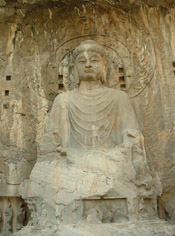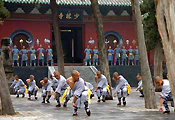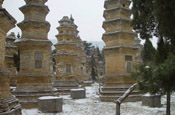|
Luoyang
Luoyang, located along the southern banks of the middle reaches of the Yellow River, is one of the seven ancient capitals of China, served sooner or later as the capital city with a history of 1592 years and for 13 different dynasties (the Xia, the Shang, the Eastern Zhou, the Eastern Han, the Cao Wei, the Western Jin, the Northern Wei, the Sui and the Tang, etc.); considered the miniature of the ancient Chinese history.
In addition to many places of interest, Luoyang takes pride in its peonies. Every April, the city's Peony Show attracts numerous visitors from home and abroad. Luoyang is also famous for its three-colored glazed pottery, bronze ware, and palace lanterns.
Recommended China Tours Including Luoyang:


|
Tourist Highlights
|
| |
 |
Longmen Caves
About eight miles south of Luoyang on the Yi River, at a spot where high cliffs on either side form a pass, is a caved area once known as the "Gate of Yi River", which later became known as Longmen, or the “Dragon Gate.” Craftsmen began work on Buddhist grottoes in 494 when an emperor of the Northern Wei moved the capital from what is now known as Datong (Shanxi Province) to Luoyang. The artistry is therefore an extension from Datong. The work at Longmen proceeded through seven dynasties, and in more than 1,300 caves, there are 40 small pagodas, and almost 100,000 Buddha statues ranging in size from one inch to 57 feet. These caves and the stone sculptures they contain rank with the caves at Yungang and Dunhuang as the great remaining masterpieces of Buddhist culture in China. |
|
|
Shaolin Temple
Shaolin Temple was established in 495 during the Northern Wei Dynasty (386-534). Bodhidharma (known to the Chinese as Da Mo), an Indian monk, came to Luoyang, the ancient capital, for spreading Buddhism at that period. Emperor Xiaowen was a believer of Buddhism so he decided to build the temple in the Songshan Mountains to house Bodhidharma.
The temple, which bore witness to the rise and fall of several dynasties, is also famous for its Martial Arts (Kung Fu). Shaolin Kung Fu is the product of the synthesis of other martial arts principles into a distinctive martial art style. An ancient Shaolin Master once said: "Study Shaolin style in great depth, then study for wisdom and train the body." This quote embodies the physical and mental strength and discipline required in the study of martial arts. In recent years, renewed interest in Kung Fu has led visitors, western & otherwise, to the steps of the temple where schooled martial arts started.
|
 |
 |
Recommended China Tours Including Luoyang:


|
|
| Other City |
|
|
 |
| Private China Tours |
|
|
 |
|

